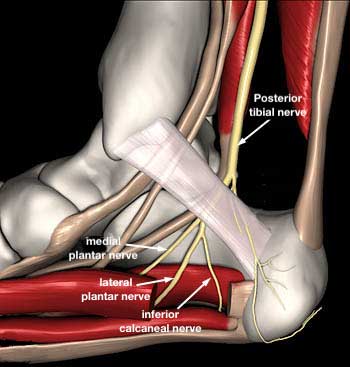Treating Baxter’s Nerve Entrapment: Conservative and Regenerative Treatments
Understanding Baxter’s Nerve Entrapment
Baxter’s Nerve:
- Also known as the first branch of the lateral plantar nerve or Inferior Calcaneal nerve. The lateral plantar nerve is a branch of the Tibial nerve, that arises below the tarsal tunnel at the ankle area.
- It innervates the abductor digiti minimi muscle and the periosteum of the calcaneus and sensory nerves in the region at then calcaneal tuberosity.
- Often entrapped at 2 possible sites- *1. Between the deep fascia of the Abductor Hallucis muscle and Quadrates Plantar muscle in the arch of the foot OR 2. more distally just below the heel bone calcaneus at the plantar fascia attachment.
- Entrapment occurs when the nerve is compressed, leading to heel pain, often confused with plantar fasciitis. Can occur separate to in conjunction of the plantar fasciitis.

Symptoms:
- Sharp, burning pain, shooting pain on the inside of the heel.
- Pain often worsens with activity and can be particularly severe in the morning.
The 2 possible sites of entrapment

Causes
Common Causes:
- Overuse injuries from activities such as running or standing for long periods.
- Anatomical variations like a heel spur.
- Inflammation or injury to surrounding tissues. Maybe confused with plantar fasciitis,.
Regenerative Treatments for Baxter’s Nerve Entrapment
Regenerative treatments focus on healing the underlying nerve compression and inflammation, promoting long-term relief. Here are the key regenerative options:
1. 5% Dextrose Perineural Injection
Evidence-Based Approach:
- Procedure: A 5% dextrose solution 0.5 ml is injected under the skin at various spots following the nerve track, just proximal to the symptomatic area. these location are known area of entrapment known as Valley points. Also known as Lyftogt Perineural Injection Therapy.
- Mechanism: The injection helps to reduce inflammation and mechanical irritation of the nerve. Physical release of the entrapment, and the dextrose normalises nerve function.
- Benefits: Provides instant pain relief, improves nerve function, and promotes healing. Allows the normal glide of the nerve.
- Studies:
- Research has shown that perineural injection therapy (PIT) with 5% dextrose is effective in treating chronic pain related to nerve entrapments, including Baxter’s nerve .
2. 5% Dextrose Hydrodissection
Evidence-Based Approach:
- Procedure: A 5% dextrose solution is used to hydro-dissect (separate) the nerve from surrounding tissues/ fascia under Ultrasound Guidance .
- Mechanism: This technique reduces mechanical compression and inflammation around the nerve. Usually faster than Perineural Injection therapy.
- Benefits: Provides immediate pain relief and long-term improvement by freeing the nerve from entrapment.
- Studies:
- Clinical evidence supports the efficacy of hydrodissection in reducing pain and improving nerve mobility in peripheral nerve entrapments .

3. Photobiomodulation (PBM)
Evidence-Based Approach:
- Procedure: A specialized device emits low-level laser light – red and infra red wavelengths to the affected area.
- Mechanism: The light energy is absorbed by cells, enhancing cellular function, reducing inflammation, and promoting tissue repair.
- Benefits: Non-invasive, painless, reduces pain and inflammation, and promotes nerve healing.
- Studies:
- PBM has been demonstrated to be effective in reducing neuropathic pain and inflammation, improving nerve function in various clinical settings .
Combining Regenerative Treatments with Traditional Podiatry Care
Integrating regenerative treatments with traditional podiatric care ensures comprehensive management of Baxter’s nerve entrapment.
Initial Phase
- Assessment: Confirm diagnosis with a detailed clinical examination and imaging studies if required (ultrasound or MRI).
- Initial Treatment: Nerve stretches and glides to help free the nerve, shoe advice.
- Regenerative Treatment:
- Begin with 5% dextrose perineural injections or hydrodissection.
- Implement photobiomodulation (PBM) sessions to reduce inflammation and promote healing.
Mid Phase
- Physical Therapy: Introduce a tailored physical therapy program focusing on stretching and strengthening exercises for the foot and ankle.
- Most of these cases is best to avoid orthotics. Shoes should be cushioning.
- Continued Regenerative Treatment:
- Maintain regular 5% dextrose injections or hydrodissection as needed.
- Continue PBM treatments to sustain anti-inflammatory effects and support nerve healing.
Long-Term Phase
- Activity Modification: Wearing appropriate footwear.
- Maintenance Therapy: Periodic regenerative treatments (e.g., injections or additional PBM sessions) if any symptoms return.
- Follow-Up Care: Regular follow-up appointments to monitor progress and adjust treatment plans as necessary.
Conclusion
Baxter’s nerve entrapment can be effectively managed using a combination of regenerative treatments and traditional podiatric care. 5% dextrose perineural injections and hydrodissection offer promising results in reducing pain and promoting nerve healing, while photobiomodulation provides a non-invasive method to enhance recovery. Integrating these treatments with physical therapy, and lifestyle modifications ensures comprehensive care and long-term relief for patients suffering from Baxter’s nerve entrapment. Our Cheltenham Podiatrists are experts in this field, and have trained overseas with world experts. If you are suffering with sharp heel pain, please book online or call the practice for an assessment.
References
- Chundru U, Liebeskind A, Seidelmann F, Fogel J, Franklin P, Beltran J. Plantar fasciitis and calcaneal spur formation are associated with abductor digiti minimi atrophy on MRI of the foot. Skeletal Radiol. 2008;37(6):505-510.
- Hamblin, M. R. “Mechanisms and Applications of the Anti-Inflammatory Effects of Photobiomodulation.” AIMS Biophysics, 2017.
- Rahimzadeh, P., Imani, F., Faiz, S. H. R., et al. “Perineural Injection Therapy with 5% Dextrose for the Treatment of Chronic Sciatica: A Randomized Clinical Trial.” Anesthesiology and Pain Medicine, 2017.
- Wu, Y. T., Ho, T. Y., Chou, Y. C., et al. “Hydrodissection for Carpal Tunnel Syndrome: A Randomized, Controlled, Double-Blind Clinical Trial.” Muscle & Nerve, 2019.
- Wu Y-T, Chen Y-P, Lam KHS, Reeves KD, Lin J-A, Kuo C-Y. Mechanism of Glucose Water as a Neural Injection: A Perspective on Neuroinflammation. Life. 2022; 12(6):832. https://doi.org/10.3390/life12060832
Latest News
Ankle Arthritis
Understanding Ankle Arthritis and Regenerative Treatment Options in Podiatry Ankle[…]




